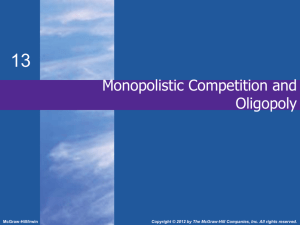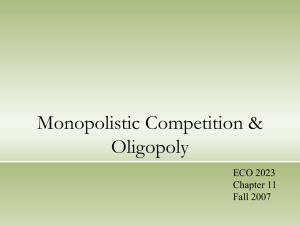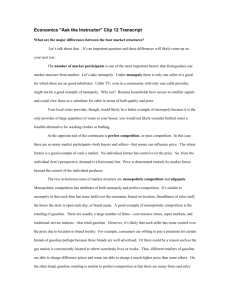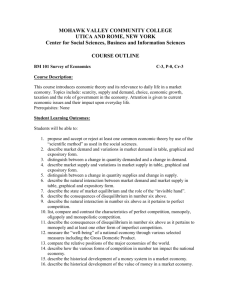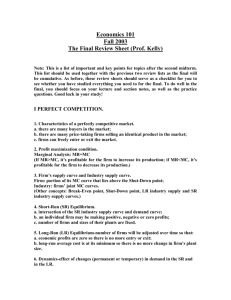Business Competition & Market Structures Presentation
advertisement
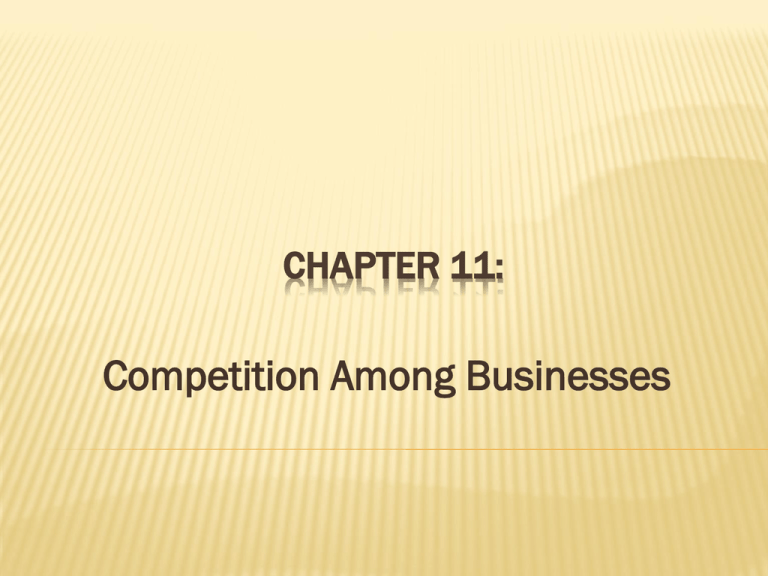
CHAPTER 11: Competition Among Businesses WHY IT MATTERS? Business competition influences the price, quality, and quantity of ALL the retail products YOU purchase in the marketplace The number of firms in the market and their size determine the prices you pay as a consumer AND the quality of the products you are provided MARKET STRUCTURE Market structure: a set of conditions that describes the characteristics of a market in which a business firm competes 4 major characteristics: Number of firms Ability of a business to set product price Product differentiation Ease of entry into a market 4 major market structures: Perfect competition Monopolistic competition Oligopoly monopoly PERFECT COMPETITION Perfect competition: market structure in which a large number of firms all produce an identical product Many sellers: hundreds or more businesses produce the same product and each business supplies only a small fraction of the entire market’s production Identical goods or services: one producer’s product is indistinguishable from another’s Only reason to buy one product rather than the other is price difference Complete information exists: buyers and sellers know all there is to know about the product and its price No ONE business can influence the market price for the product by changing production levels because there are so many sellers Also know about the competitor’s products Free entry: sellers can enter or leave the market whenever they wish with relatively SMALL costs SUCCESSFUL businesses in perfectly competitive markets MUST TAKE or ACCEPT, the PRICE DETERMINED by the MARKET and decide HOW MUCH TO PRODUCE at that price MONOPOLY Monopoly: opposite of a perfectly competitive market Pure monopoly: a market structure with only ONE SELLER in the market No close substitutes: No other firm offers a similar product Barriers to entry: potential rivals are unable to enter a market because of LEGAL RESTRICTIONS or HIGH INVESTMENT COSTS LEGAL MONOPOLIES Legal monopolies: Natural monopolies: telephone, electric, and water companies Often called public utilities Markets regulated by government Determine the services the utilities provide and how much they are permitted to charge Government licenses: grants a particular business the right to operate without direct competition Patents as monopolies: gives the inventor the private property right to a new product or idea for 17 years Copyrights and trademarks: through the Federal Copyright Office, the government gives the authors of original writing and artistic work a copyright A special monopoly for the lifetime of the author, plus 50 years Trademarks: special designs, names, or symbols that identify a product, service, or company MONOPOLISTIC COMPETITION Monopolistic competition: a market structure with many firms that offer similar but not identical products Also called: imperfect competition Many firms in this type of competition Each firm can raise or lower its price to alter its sales Differentiated products: emphasize distinctive features of their products to differentiate them from competitors’ products Describe their products: “new and improved”, “used by professionals”, or “the best value for the lowest price” Customer service: special services that businesses provide to attract you as a customer Warranties and support: will convince you to buy one product rather than another Prestige: use highly visible labels to differentiate their products People who purchase a popular brand of sunglasses are often interested in more than simply protecting their eyes from the sun Good EXAMPLES of monopolistic competition: Clothing and restaurant industries Relatively easy to enter or exit these markets BUT competition is INTENSE, and businesses must work hard to create a special demand for their products OLIGOPOLY AND COMPETITION Oligopoly: a market structure in which a few large businesses supply most or all products in a market Examples: cereals, major appliances, carbonated soft drinks Has a HIGH CONCENTRATION RATIO Concentration ratio: percentage of industry’s sales accounted for by its four largest firms; for Oligopoly the percentage is 60% or MORE Businesses in Oligopoly are able to adjust their prices If one company reduces its price, the others are likely to reduce prices to keep their customers As a result, all companies may end up with lowers prices and earnings OLIGOPOLY AND COMPETITION CONT… Restricting competition: strong temptation to restrict price competition so they all can earn higher profits Collusion: an agreement in which companies restrict production to raise prices and profits May result from an explicit agreement among companies, or it can occur in unspoken understandings that businesses will behave in certain ways One form of collusion: PRICE FIXING Price fixing: all firms in a market agree to charge the same or similar prices OLIGOPOLY AND COMPETITION CONT…… Obstacles to successful collusion: Companies in an oligopoly must agree on how much higher the price should be than it would be in a competitive market Companies with lower production costs may want smaller price increases than those with higher costs Companies must agree on the amount by which each will reduce production Price Production cuts Law enforcement The potential of new companies entering the industry Cutting back on production reduces sales Each company wants the others to bear the brunt of cutting back production = leaving one company to sell more at the higher price IF collusion is SUCCESSFUL in raising the price, the higher price will attract new companies into the industry In the U.S. it is against the law – SHERMAN ANTITRUST ACT – to restrain trade, so the LAW presents the greatest obstacle to COLLUSION BUSINESS MERGERS Business firms expand in two ways: Internally: expand their activities by adding facilities, equipment, and personnel based on current or predicted demand Externally: require mergers Merger: occurs when one business buys another Following a merger, the acquired firm is either dissolved or becomes a division of the new firm Another term for merger: “buyout” Reasons for merging: Add new products, gain access to established markets, and/or to diversify their business therefore, “spreading the risk” Benefits of increased size Eliminate a competitor Reduce costs by acquiring assets like marketing or transportation facilities TYPES OF MERGERS: Vertical: combination of two or more companies involved in different steps of a production process Horizontal: combination of two or more companies engaged in the same business Conglomerate: combines two or more unrelated companies under single management Can increase an industry’s concentration ratio by eliminating a competitor Allows the company to diversify the range of products it sells so that if one product does not sell well, the entire company will not fail Instead of merging, some firms in an oligopoly establish joint ventures with other companies Joint Ventures: two companies keep their independence while cooperating on a particular project Allows companies to combine resources without experiencing many of the problems of mergers MARKETING Marketing: everything that takes place between production and purchase Differentiate their products Establish competitive prices Develop effective promotions See that products are available when and where consumers want them Figure 11-4 pg. 193 (IMPORTANT) The Major Marketing Functions THE FOUR P’S OF MARKETING Product: must be the one consumers want, features and quality consumers expect for the price they pay Questions researchers ask: Value most? Quality standards expected? Services desired? Price: search for the price that enables them to earn the most profit Price must cover fixed costs and variable costs Uses these costs to compute break-even point – the point of production at which income from sales equals total fixed and total variable costs If total variable and fixed costs are not met = company will have a loss If costs are below total and variable costs = company will make a profit THE FOUR P’S OF MARKETING CONT… Promotion: the way that business get their messages to consumers Advertising, direct mail, personal contact If consumers don’t know about a product, they won’t buy it Place: for a product to be useful, it has to be in a place when and where consumers will buy it Do not think of place as a specific location…internet, mail order catalogs ECONOMICS OF ADVERTISING Two kinds of advertising: Informational: tells potential customers about product characteristics and prices Low-cost means of helping customers make informed decisions about the choices among competing products Argued that it reduces customer search time and reduces their personal costs in comparing product characteristics and prices Persuasive: convince you to buy the product for a specific reason (even if it is not always the truth) Two concerns by economists: Often based on extravagant claims that confuse potential customers and insult their intelligence Tends to reduce competition and limit the number of firms that are able to compete in a market Perfect competition: no difference in the product that businesses sells, so there should be no need to advertise Monopoly: only one seller and that seller should not need to advertise because it has no competition Monopolistic competition: extensive advertising ULTIMATE GOAL OF MARKETING: Determine what buyers want To inform To persuade EXAMPLES OF OLIGOPOLY Steel industry Aluminum Film Television Cell phone Gas EXAMPLES OF MONOPOLY There is a single seller. There are no close substitutes for the firm’s product. There are barriers to entry. Public utilities such as gas, electric, water, cable TV, and local telephone service companies, professional sports teams EXAMPLES OF MONOPOLISTIC COMPETITION Monopolistically competitive markets have the following characteristics: There are many producers and many consumers in the market, and no business has total control over the market price. Consumers perceive that there are non-price differences among the competitors' products. There are few barriers to entry and exit Producers have a degree of control over price. WORKBOOK PAGES 186-187 ANSWERS: Matching: 1. 2. 3. 4. 5. 6. 7. 8. E D G A H B F C Multiple Choice 1. A 2. D 3. C 4. B 5. A 6. B 7. D 8. D 9. C 10. C 11. B 12. B 13. D 14. D







